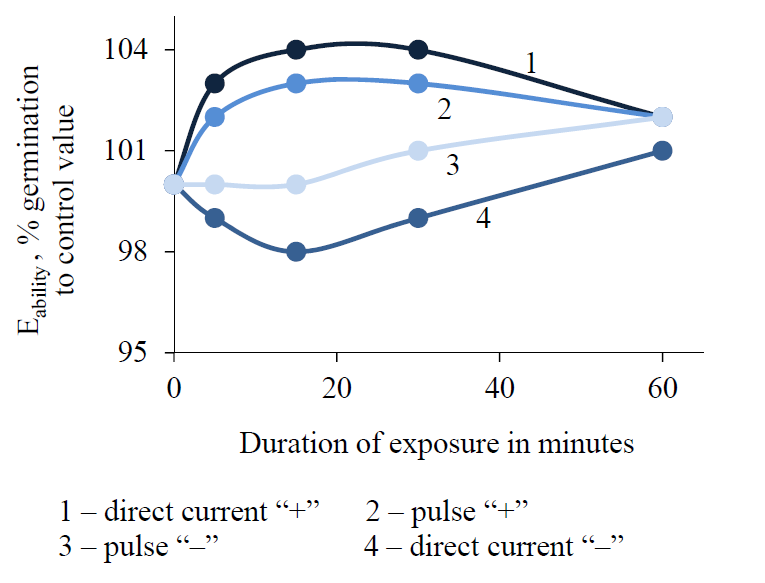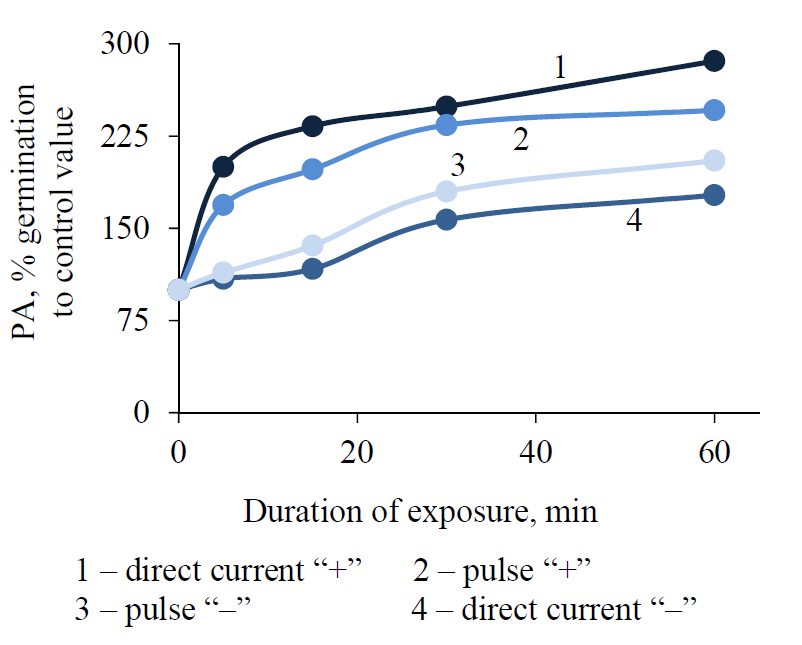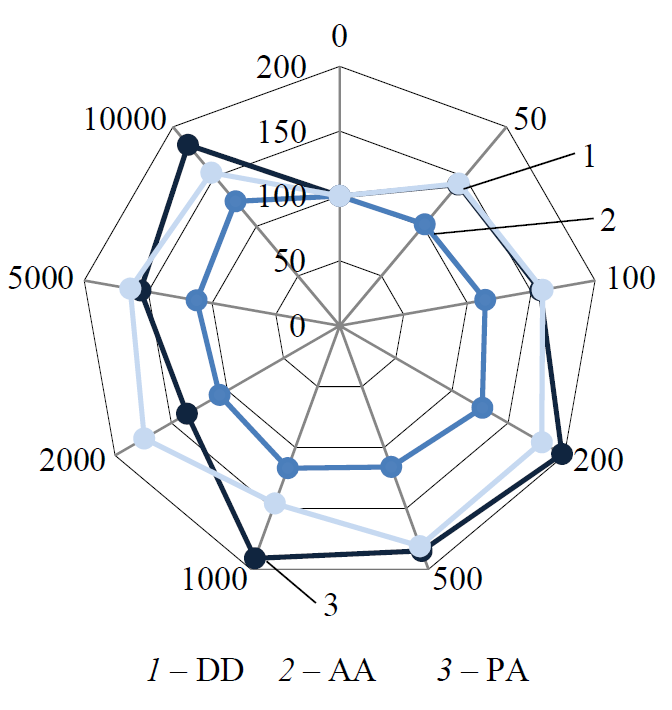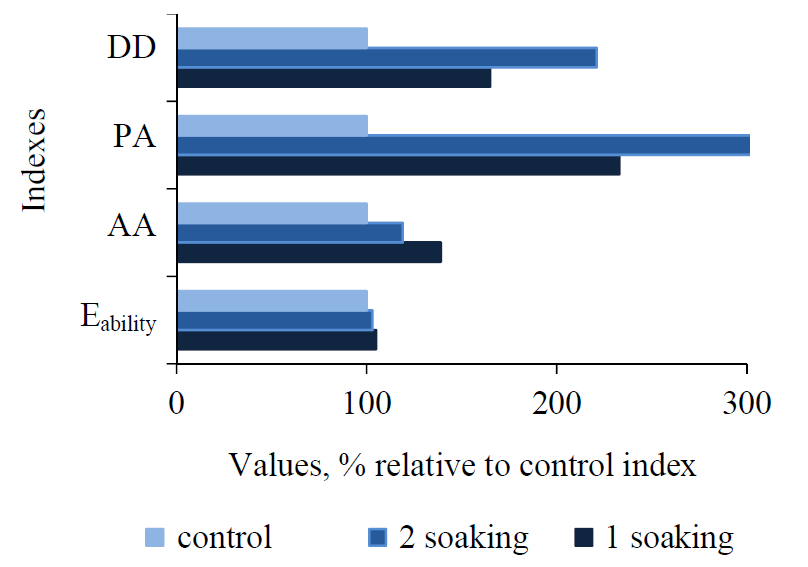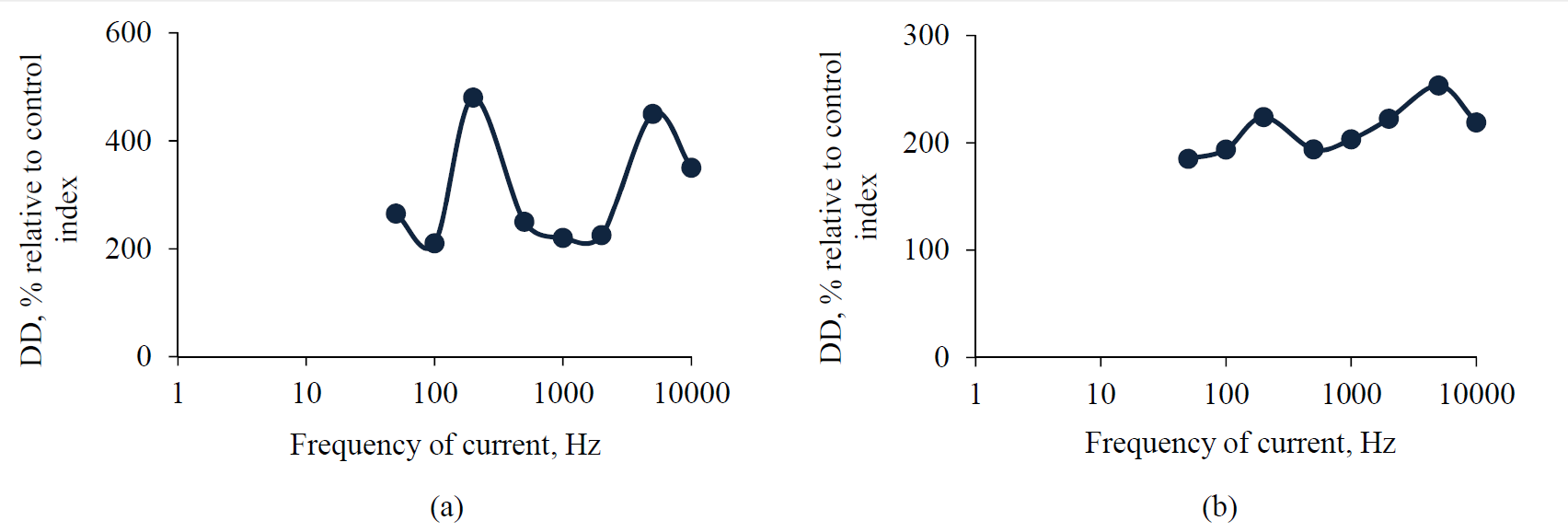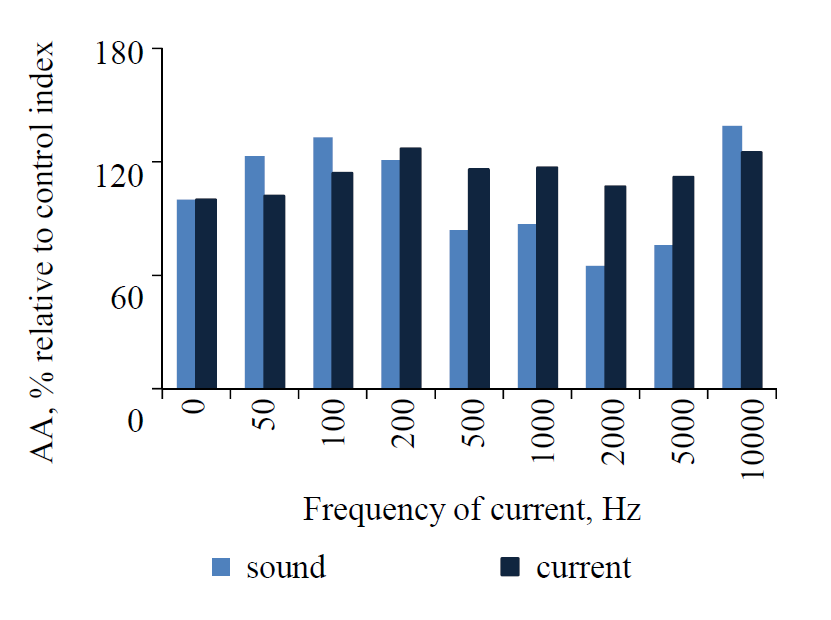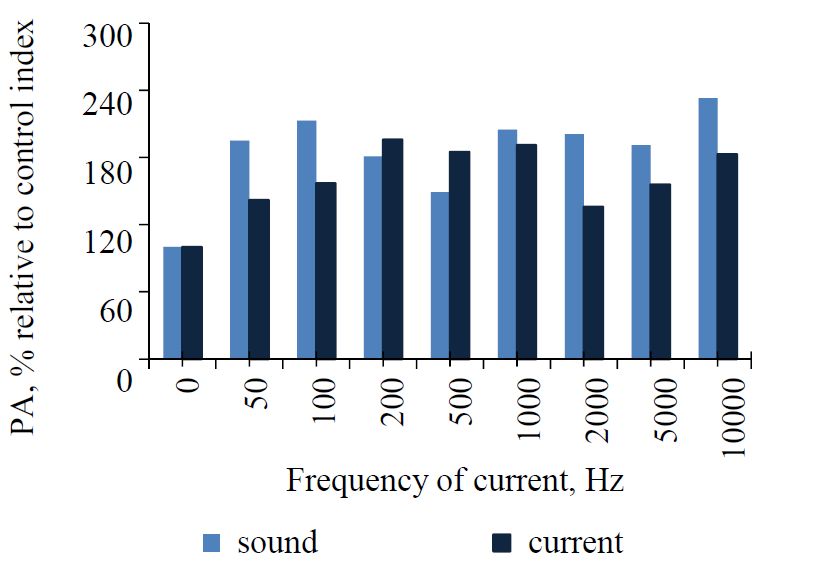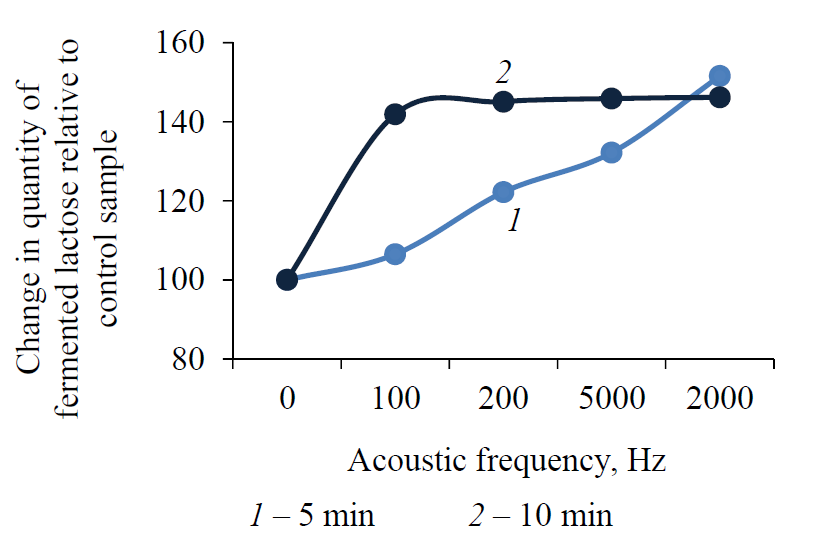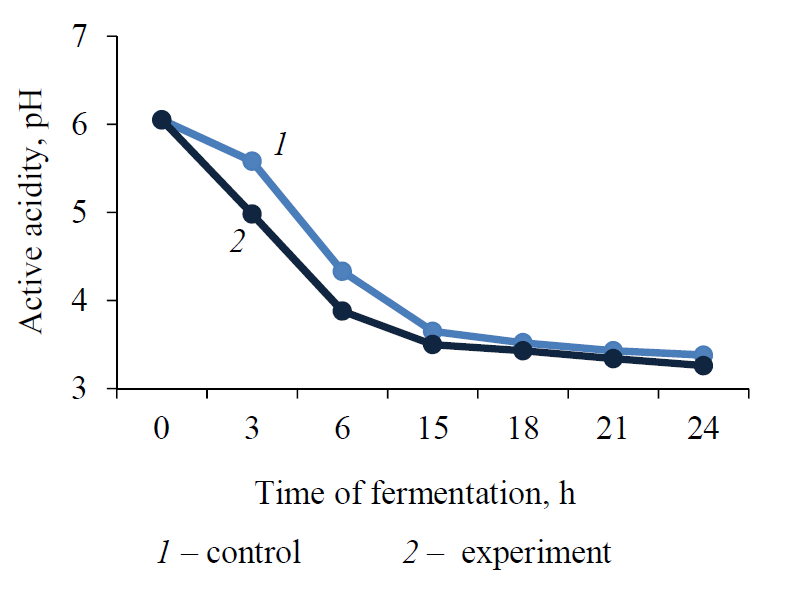Аннотация
The paper deals with urgent issues of development of resource-saving methods of biotechnological processes intensification. The main purpose of the work is to show the efficiency of using extremely low doses of physical factors impact in food biotechnology. Acoustic and electric treatment was in various modes. Impact capacity did not exceed 10-4 W/kg. The duration of exposure ranged from 5 to 15 min. Barley grains enzymes and lactic acid microorganisms were subjected to treatment. Impact of vibration as a physical factor, its frequency is considered as a priority in controlling growth and biochemical processes in biological objects. Impact frequency in the range of 50–10000 Hz influences the activity of hydrolytic enzymes in bimodal way. It is presented in the article. The coincidence of the frequency ranges of the maximum activity of enzymes in the model reactions with the ones in the grain of barley under the treatment of alternating current and sound is noted. Improvement of all indexes of germinating barley and improvement of the quality of the finished malt were observed in these ranges. Low-intensity acoustic treatment at a frequency of 2000 Hz contributed to an increase in β-galactosidase activity of the CT-95 Str. thermophilus strain. Selected ST-95 Str. thermophilus strain was used in the starter composition for the experimental sample production of fermented melted milk. The fermentation process intensification was observed. The lactose content of this product is 30% less in comparison with the feedstock. The use of traditional starter without a selected strain can reduce the lactose content by an average of 7.5%. The results of biotechnological processes modification by means of the treatment of enzymes and extremely low doses of physical factors impact used in meat technologies are observed. Thus, the prospects of using low-intensity physical effects of vibration in the development of innovative food technologies are substantiated. It is also promising to use these technologies in making absolutely new food products with different qualities.Ключевые слова
Food biotechnology, biotransformation, hydrolytic enzymes, barley grain, lactic acid microorganisms, the impact of physical factorsВВЕДЕНИЕ
It is believed that physical factors to a large extent influence the life activity of biological objects [1], including biochemical processes in them. In nature, such factors are temperature, light, and pressure. In the food industry there is an approach to use electro-physical methods while processing raw materials and food products. These methods are characterized by the lack of inert work of the equipment, by reduction of duration of processing objects and high efficiency of energy use. The electro-physical factors include the impact of electromagnetic fields (EMF) of high-frequency (HF), ultra-high-frequency (microwave) and infrared (IR) bands, magnetic fields, electro-contact (EC) processing methods, electrostatic processing methods, pulse processing methods, ultrasonic exposure, pulsation and vibration processing methods, the use of laser, ultraviolet (UV) processing, radiation ionization of materials. The choice of impact factor is determined by the goals and objectives. One of the main processing parameters is the power of the applied effect – W. Electrochemical cleaning, electric separation, electroplating, electro-deposition, dispersion, emulsification, homogenization, bringing the food product to readiness using microwave and IR heating are widely used and carried out at relatively high specific power (Ws.p. = 1.5–2.0 kW/kg) [2, 3].
In the works of scientific schools (at the head of academicians Devyatkov N. D. and Rogov I. A.) the bio effects such as changes in cell morphology, metabolic processes, enzyme activity, growth rate, increase or decrease in survival, change in functional processes in biological objects are highlighted. These effects become manifested when living systems are subject to EMF [3, 4]. To implement the biological effects of physical factors, an important parameter is the dose of exposure. Numerous experiments described in articles show that biological objects react to physical impact even at the minimum applied power and significant effects are observed at a very low-intensity exposure. In scientific works this issue is given much less attention than to the thermal effects. The interpretation of the results of the biological effects of physical factors is diverse, due to the complex structure of biological systems both containing a large number of negative feedbacks that can support homeostasis and trying to neutralize the external influence [5–7]. As a rule, bio effects are shown at Ws.p. ≤ 10-3 W/cm2, when increase in temperature of the object by more than one degree is excluded, and these effects do not depend on the intensity of the impact up to those Ws.p. values at which the thermal effect becomes noticeable [3]. At this stage of development of science and technology, scientists are forming a new scientific approach to the use of ultra-small doses of various physical and chemical effects to intensify the life of biological systems [8–15].
The purpose of this work is to show the efficiency of extremely low doses of different physical factors impact on biochemical processes in biological objects and to justify the prospects of using these effects while processing food raw materials and obtaining food with improved quality.
ОБЪЕКТЫ И МЕТОДЫ ИССЛЕДОВАНИЯ
Barley grain as the main biological object was taken for germination to malt. The significance of this object for research is due to the value of its biochemical composition: amino acid-balanced protein (8–12%), starch (62–68%), rough fiber (up to 5.2%), minerals (2.9%), lipids (2.4%), ashy substances, mucus, enzymes, different vitamins. Barley sprouts are also valuable, and have healing properties due to the activity of vitamins (C, B12, K and provitamin A) in their composition, as well as the content of trace elements (Zn, Cu, Mn, Fe, etc.). In addition, barley is one of the main products for obtaining malt and necessary for the production of whiskey and beer. That fact says about the importance of the obtained scientific results for practical purpose. A promising scientific approach to the food industry is the use of barley malt in the production of various starchy food, confectionery, bakery and culinary products. Barley varieties (“BIOS”, “Ryadovoy”, “Scarlet”, “Odessa-115”) with different germination capacity were used in the research. The object of the study was also malt obtained from the barley of above mentioned varieties.To model enzyme systems, the following enzyme preparations were used in the scientific research:
(1) “Amilosubtilin G 10X”, having amylase activity; the starch is applied as a substrate.
(2) “LAMINEX®BG Glukanase Complex”, which has cytolytic activity; wet mass of WF 200 wheat fiber is applied as a substrate.
(3) “Kazarin and bovine Pepsin”, which has proteolytic activity; the sodium Caseinate is used as a substrate.
The objects of the experiments on finding out impact of physical factors of low intensity on the properties of microorganisms were strains of thermophilic lactic streptococcus (Streptococcus thermophilus) from the collection of microorganisms of the Moscow State University of Food Production, registered in the all-Russian collection of industrial microorganisms (ST-9 Str. thermophlus, ST-13 Str. thermophlus (VKPM V-9647), ST-14 Str. thermophlus, ST-138 Str. thermophlus and ST-95 Str. thermophlus (VKPM V-7985)). These cultures are producers of the enzyme β-galactosidase and are widely used in starter cultures for many types of dairy products such as curds and sour cream, various types of sour milk, yogurt, pro- and synbiotic products.
Barley was germinated in funnels in accordance with the laboratory version of the industrial malting process. It includes that is soaking for 4 hours then air pause for 16–18 hours, the next stage was soaking again for 4 hours and then germination in a humid atmosphere for 5 days. In experimental germination the physical factors impact on the grain both after the first and after the second soaking was carried out. The methods widely used in the technology of producing malt and beer were applied for analysis of barley growth and the activity of hydrolytic enzymes [16]. The ability of grain germination (Eability), amylolytic activity (AA), proteolytic activity (PA) and the degree of grain endosperm dissolution (DD), which varies by the combined action of proteolytic and cytolytic enzymes, were determined. Eability was estimated as a percentage of the proportion of seeds sprouted on the fifth day. The value of AA was determined by the Windisch-Kolbach method, the value of PA – by the Anson method, DD – refractometrically. Different indexes of malt obtained in the experimental germination were evaluated in relation to the same indexes obtained in the control germination. Indexes of the control sample were taken as 100%.
In studying the impact of physical factors of low intensity on the life of thermophilic lactic streptococci, the following methods of identification, control and application of probiotic and lactic microorganisms were used [17, 18]:
– Control of the strain and starter cultures for purity was performed by microscopy of the stained smear of bacterial suspension.
– Quantitative accounting of lactic acid microorganisms was carried out in accordance with GOST 10444.11-89 immediately after application of the ferment (zero point) and after fermentation made by limit dilutions in sterile physiological solution. The nutrient medium was sterilized skim milk.
– Active acidity (pH) of dairy raw materials and fermented baked milk was determined according to GOST 26781-85 using pH meter (pH meter mark-150 MA) with the help of instructions attached to it.
– Titratable acidity of raw milk and fermented baked milk was determined according to GOST R 54669- 2011 by titration with sodium hydroxide solution.
– The rate of fermentation was determined by fixing the time of clot formation, which characterized the activity of curdling milk by the studied ferment.
– Water-holding capacity of the clots generated in thefermented baked milk was determined by centrifugation method similar to the determination of water-holding capacity of food fiber.
– To check the purity of the culture, an ultra-small preparation was made.
– β-galactosidase activity of lactic acid bacteria was estimated by their acid-forming rate in milk calculating the amount of lactic acid formed during fermentation.
As the factors of physical impact, EC processing was used when passing through the object of direct current, industrial frequency current and alternating current with a frequency of 50 to 10,000 Hz, as well as acoustic treatment of the object in the same frequency range. Specific frequencies from 50 to 20000 Hz were chosen for the experiment, starting with the power frequency of 50 Hz, and then 100, 200 ... with a step- by-step increase in the frequency of 2–2.5 times while maintaining the power and duration of exposure. In the experiments with alternating current treatment, the duration of exposure was 15 minutes, and in the experiments with acoustic treatment it was 5 minutes. Power impacts did not exceed 10-4 W/kg. The EC method and acoustic treatment were used because these methods are simple and convenient for energy generation.
РЕЗУЛЬТАТЫ И ИХ ОБСУЖДЕНИЕ
All the experiments were carried out 4–5 times. Processing of experimental data was carried out using the method of mathematical statistics. The standard deviation of the directly measured value was calculated as follows:

where xi is the measured quantity; N – number of direct measurements; j – serial number of direct measuring; s cons . the magnitude of the consistent error is the sum of both the instrument error and the round-off errors in the measurements on the instrument scale. The latter can be estimated as ![]() where u is the finest reading. This is justified by the main theorem of calculus of probability.
where u is the finest reading. This is justified by the main theorem of calculus of probability.
The average value of the indirectly measured quantity was calculated as
![]()
a mean square deviation of the indirectly measured value was

The results show that the impact of direct current on the moistened grain in the embryo with “+” polarization causes the concentration of negatively charged ions there, which contributes to the activation of the embryo and favorably affects the Eability of barley of different quality. A typical dependence of Eability value of barley grain from the duration of EC treatment under conditions of strict polarization of the grain embryo is adaptive in nature. At first a sharp change in the indicators happens in the positive or negative way relative to the control value, depending on the sign of polarization of the embryo, and then a gradual change of its value towards the control value takes place, that is there is a primary activation effect (“shock reaction”) on the impact of external irritant factor with subsequent adaptation (Fig. 1). The activity of enzymes can increase both at “+” and “–” polarization in the embryo, but at “+” polarization the effects are more significant (Fig. 2). Changing from constant to pulsating mode of passing current through the moistened grain while maintaining the sign of polarization of the embryo leads to a decrease in both positive and negative effects, and as for the Eability value, it is negative on the whole. At the same time, the maximum increase in Eability value relative to control value is 3–10% depending on the quality of barley grain, while the enzyme activity can increase 2–2.5 times (Figs. 1 and 2). It says that the oscillatory nature of the impact has a greater effect on the activity of enzymes than the polarization of the embryo, that is associated with a characteristic feature of biological systems (oscillatory processes).
EC treatment of moistened barley grains by alternating current of industrial frequency allows realizabion of external steady impact of the given power at fluctuations of values of amplitude from maximum positive to maximum negative-going. The results of the experiments show that while using alternating current, when there is no unidirectional movement of particles inside the biological object, there is no decrease in germination (Fig. 3).
Figs. 1 and 2 use the following symbols: direct current “+” is the impact of unidirectional direct current with positive-going polarization of the grain embryo; direct current “–” is the impact of unidirectional direct current at negative-going polarization of the grain embryo; pulse “+” is the impact of unidirectional pulsating current with positive-going polarization of the grain embryo; pulse “–” is the effect of unidirectional pulsating current at negative-going polarization of the grain embryo.
From the point of view of increasing the number of germinated seeds, EC treatment with current of industrial frequency has no apparent advantage, but in terms of enhancing enzymatic activity is much more effective than EC treatment with direct current. The favorable influence of the vibration treatment the efficiency of enzyme systems can prove that the germinating grain has self-oscillatory modes of activity. This fact conform sto the literature data [19–24]. In addition, on an industrial scale, it is impossible to implement conditions that ensure strict polarization of the embryo of each grain, while AC processing gives a specific technology solution and array of process vessels.
It is common knowledge that the main purpose of germination of barley to malt is the accumulation of amylolytic enzymes in the grain, that allows the use of barley malt not only for beer, but also in the processes of saccharification of vegetable raw materials. However, when malting, each enzyme plays an important role and good quality of the finished malt can be obtained with their full interaction. To convert as much malt extract as possible into a solution, combined action of hydrolytic enzymes, such as amylases, proteases, and citas, is significant. One of the main results of malting is a change in grain structure because of the combined action of cytolytic and proteolytic enzymes that dissolve the cell walls of the grain endosperm. Cell walls are formed mainly by hemicellulose and gummi substances. Hemicellulose and gum substances consist of 80–90% of β-glucan and 10–20% of pentosans, but they have different solubility in hot water due to the large difference in the molecular weight [25]. The composition of cell walls also includes protein (5%) and insoluble fiber (cellulose) (2%). Enzymes of the cytolytic complex hydrolyze non-starch polysaccharides of the cell walls, resulting in the formation of a framework permeable to amylolytic and proteolytic enzymes.
The role of proteolytic enzymes is not only in the cleavage of high-molecular proteins to amino acids, which are necessary for the development of the embryo and for the synthesis of enzymes, but also in the hydrolysis of protein substances, firmly connected to the walls of endosperm cells. Thus, the process of dissolution of the cell walls of starch grains is facilitated by enzymes cytolytic complex.
The action of amylolytic enzymes appears mainly in mashing, and in the process of germination starch is hydrolyzed by amylases slightly. Germination is stopped when the accumulation of amylolytic enzymes in the grains becomes maximum.
After EC treatment while malting the improvement of dissolution of the grain endosperm makes the quality of malt higher. When mashing such malt, wort viscosity decreases and its filtration facilitates.
Being self-oscillatory in nature, the main biochemical processes in biological objects determine the possibility of regulation of the main indicators of germinating barley and malt obtained from it by varying the frequency of the given power. Thus, the effect of current frequency on barley malting was studied as the next phase of this work.
Figs. 4 and 5 show comparative diagrams of the effect of low-intensity EC treatment on the change of the efficiency of the hydrolytic enzymes main groups at different stages of the malting process. The results are presented for the entire range of investigated current frequencies.
The analysis of the comparative diagrams shows that as a result of the given power, the activity of proteolytic and cytolytic enzymes increases in an advanced way. Under the same modes of EC treatment, the activity of amylases increases by 1.1–1.2 times, and the activity of the combination of proteolytic and cytolytic enzymes increases by 1.5–20 times relative to the control value. Similar results were obtained in the study of EC exposure using an industrial frequency current in a time interval of 5–60 min (see Fig. 3).
Thus, low-intensity EC treatment of moistened grain mass of barley with alternating current is an effective way to improve the quality of barley malt. The frequency of the current is an important parameter of impact. If one change it, it is bossible to control the growth and biochemical processes in the germinating grain.
To confirm the priority role of the oscillatory nature of the physical effects that increase the growth and activate biochemical processes in biological systems, a physical factor of a different nature such as steady acoustic vibrations was chosen. They being physical entities are mechanical vibrations in elastic medium. Low-intensity acoustic treatment can be implemented using acoustic (sound) waves. This is interesting from both a scientific and practical point of view. In contrast to the EC impact, acoustic treatment of barley for germination to malt can be carried out before soaking (dry-air mode). It is an effective and fairly simple method of processing in production conditions.
After low-intensity sound processing, similar to AC treatment, the change in enzyme activity is much higher than the change in Eability. Proteolytic enzymes show the greatest sensitivity to the effects, their activity in some modes of treatment increases by 2–3 times (Fig. 6). Depending on the frequency of exposure and quality of grain AA can be increased relative to the control value to 142 %, PA – up to 299 %, DD – up to 229 %.
Fig. 7 shows the growth and enzyme efficiency of barley after low-intensity acoustic impact on moistened grain mass. A comparison of the parameters is given for the frequency mode in which no negative effects were observed. It can be seen that the change in enzyme activity is much higher than the change in Eability, and proteolytic and cytolytic enzymes react to the given power is much stronger than amylolytic ones do. This is in accordance with the results obtained while processing dry grain under the same conditions, as well as the results of low-intensity EC processing of raw grain. The characteristic feature is the bimodal nature of the dependence of different indexes of the obtained malt on the frequency of the used exposure.
On the basis of the obtained results, technological schemes, array of process vessels of continuous processes for producing high quality barley malt using low-intensity, low-energy EC and acoustic treatment were substantiated from the scientific point of view and worked out. Experimentally established dependences can be used not only in making innovative technologies of malting, but also in technologies for producing sprouts of different cultures for use in human nutrition as a source of active enzymes, a complex of mineral and organic substances, various vitamins, including antioxidant vitamins [26].
The obtained results became the basis of the scientific concept of a fundamentally new method of modification of biotechnological processes by the combined action of enzymes and extremely low doses of physical factors impact [19, 27]. The combined action of cytolytic enzymes and current modified the properties of wheat fiber “Vitacel WF 200”. On the basis of this, a filler with improved functional and technological properties was obtained, the addition of that in minced meat providesd an increase in the quality of the finished product, and also allowed more efficient use of expensive meat raw materials due to its greater yield [27]. A method of applying the combined action of proteolytic enzymes and low- intensity acoustic treatment to modify the properties of tough meat raw materials and meat raw materials with a high content of connective tissue was proposed. This processing led not only to the improvement of consumer goods properties of the finished product, but also to an increase in its yield. In addition, the new type of impact was easily integrated into standard technologies [19].
To correlate the vibrational nature of biochemical reactions with the frequency of the given power, it was interesting to study the impact of low-intensity physical effects on the efficiency of enzyme preparations in model experiments of hydrolysis of biopolymers. In experiments with model enzyme systems, as well as in experiments with barley grains, the bimodal nature of the dependence of enzyme activity on the frequency of the given power was observed (see Figs. 8 and 9). They are a stable maximum biological effect of physical factors at a frequency of f = 200 Hz and diverse effects in the frequency range of 1000–5000 Hz.
In the experiments concerning the current impact on barley grain in the frequency range of 50–10000 Hz, when the energy of the quantum (EQ) of vibrational and wave effects did not exceed 10-10 eV and the thermal effects were minimized, we observed the analogy of the biological action of EC and acoustic treatment such as the maximum activity of hydrolytic enzymes using frequencies of 100–200 Hz and 10000 Hz (see Figs. 10, 11). These results allowus to come to the conclusion that the biological effect of the physical factors of oscillatory nature depends mainly on the variable component of the impact, its frequency. The results presented in this paper conform to the results of other scientists who conducted research on biological systems and confirmed the fundamental role of vibrational processes in the life of biosystems [21, 28–31].
The coincidence of the two frequency ranges of the maximum activity of enzymatic hydrolysis processes in the model reactions and the maximum increase in barley growth under the impact of alternating current and acoustic treatment led to the conclusion about the main role of the structural resonance of the active key hydrolytic enzyme with its two own vibration frequencies and offered a qualitative physico-chemical model of enzymatic processes sensitive to external low-intensity physical forces having vibrational nature. The role of the frequency factor was confirmed in the experiments on the modification of the lactose fermentation process when using extremely low doses of acoustic exposure. Two strains were studied such as ST-13 Str. thermophlus and CT-95 Str. thermophlus, which had the highest and lowest β-galactosidase activity, respectively. Technological properties of strains were determined by experimental and control samples during fermentation of milk. Control samples were not subjected to acoustic treatment.
The results showed that both single and double acoustic treatment of the CT-13 Str. thermophilus strain at different exposures in the frequency range 100 Hz – 5 000 Hz had virtually no effect on the acid- forming ability and enzyme efficiency, but the CT-95 Str. thermophilus strain showed a significant difference in the change of these parameters in comparison with the control samples (Fig. 12). The strain subjected to low-intensity acoustic treatment at a frequency of 2000 Hz for 5 minutes (selected strain) had the greatest index of lactose-fermenting activity, that was the most active acid and gave the greatest increase in the quantity of cells.
The Selected ST-95 Str. thermophilus strain with high β-galactosidase activity was used in the experiments to obtain fermented baked milk with low percentage of lactose. In this case, the control samples were the samples of milk obtained using the model of symbiotic starter consisting of Str. thermophilus and Lactobacillus delbrueckii subsp. Bulgaricus. Experimental samples of fermented baked milk were obtained using the selected ST-95 Str. thermophilus strain, and Lactobacillus delbrueckii subsp. Bulgaricus in the ratio of 4:1.
Fig. 13 shows the dynamics of changes in the active acidity in the process of fermentation of baked milk using a typical and experimental starter. The analysis of the results indicates a more intensive fermentation process in the period of first 4 hours after the introduction of the experimental starter into the baked milk. In addition, in the experimental samples, when producing the fermented baked milk, calcium Caseinate phosphate complex of dairy raw materials reached the isoelectric point (pH 4.58–4.64) faster than in the control samples, that led to its curdling and the formation of a dense clot.
Determination of the mass fraction of lactose in the feedstock, as well as in experimental and control samples of fermented baked milk showed that the amount of lactose in the experimental fermented baked milk was less than 30% compared to the feedstock, while the amount of lactose in fermented baked milk produced with the help of a traditional starter (unselected strain), decreased by an average of 7.5%.
The organoleptic characteristics of the test samples were the same as those of the control sample: the clot was dense, smooth, with a cream color, homogeneous throughout the mass, characteristic sour-milk taste and with a pronounced taste of baked milk without off- flavour and smells. That is, in the development of experimental samples of fermented baked milk, the product was obtained to the maximum extent close to the traditional product, but with a low percentage of lactose.
ВЫВОДЫ
Thus, using extremely low doses of physical forces of vibrational nature to regulate the life of biological systems is a promising scientific approach to work out innovative technologies for processing food raw materials. It will accelerate the main technological stages of production, improve product quality at low material and energy costs. The principle of the combined effect of enzyme preparations and low-intensity physical factors can be used in food biotechnology to make new food for different purposes.КОНФЛИКТ ИНТЕРЕСОВ
The authors state that there are no conflicts of interest.
БЛАГОДАРНОСТИ
The authors thank Margosian Susanna Sagrantovna, Deputy Head of the Scientific and Technical Information Department, the Moscow State University of Food Production for assistance in preparing the article.ФИНАНСИРОВАНИЕ
The research was supported by the Ministry of Education and Science of the Russian Federation, (the unique identifier of the project is RFMEFI57418X0191).
СПИСОК ЛИТЕРАТУРЫ
- Tompkins P. and Berd K. Taynaya zhiznʹ rasteniy [The secret life of plants]. Moscow: Homeopathic Medicine Publ., 2006. 444 p. (In Russ.).
- Rogov I.A. Ehlektrofizicheskie metody obrabotki pishchevykh produktov [Electrophysical methods of processing food products]. Moscow: Agropromizdat Publ., 1988. 582 p. (In Russ.).
- Betskii O.V., Devyatkov N.D., and Kislov V.V. Low Intensity Millimeter Waves in Medicine and Biology. Critical Reviews in Biomedical Engineering, 2000, vol. 28, no. 1–2, pp. 247–268.
- Rogov I.A. Biologicheskie aspekty mikrovolnovykh pishchevykh tekhnologiy [Biological aspects of microwave food technologies]. Electronic processing of materials, 2000, no. 5, pp. 115–125. (In Russ.).
- Rubin A.B. Fundamentals of Biophysics. Beverly: Scrivener Publ., 2014. 226 p. DOI: https://doi.org/10.1002/9781118842768.
- Slavetskaya M.B. and Kapay N.A. Sverkhmalye dozy biologicheski aktivnykh veshchestv kak osnova lekarstvennykh preparatov [Ultra-low doses of biologically active substances as the basis of drugs]. Moscow: Advertising group Department–72 Publ., 2011. 168 p. (In Russ.).
- Voeykov V.L. and Korotkov K.G. Novaya nauka o vode [New science of water]. Moscow: DrK Publ., 2017. 212 p. (In Russ.).
- Epstein O.I. Ultralow doses (History of the research). Moscow: RAMS Publ., 2009. 302 p. (In Russ.).
- Burlakova E.B., Konradov A.A., and Maltseva E.L. Deystvie sverkhmalykh doz biologicheski aktivnykh veshchestv i nizkointensivnykh fizicheskikh faktorov [The impact of ultra-low dose of biologically active substances and low-intensity physical factors]. Russian Journal of Physical Chemistry B: Focus on Physics, 2003, vol. 22, no. 2, p. 21–40. (In Russ.).
- Kulichenko E.N. Chudo sverkhmalykh doz [Miracle of ultra-low doses]. Tyumen: Russian week Publ., 2014. 152 p. (In Russ.).
- Konovalov A.I. and Ryzhkina I.S. Highly diluted aqueous solutions: Formation of nano-sized molecular assemblies (nanoassociates). Geochemistry International, 2014, vol. 52, no. 13, pp. 1207–1226. DOI: https://doi.org/10.1134/S0016702914130072.
- Ivanenko G.F. and Burlakova E.B. The effect of low dose-rate radiation on thiol-disulfide system and lipid antioxidants in blood plasma of exposed persons. Radiation and Risk, 2017, vol. 26, no. 4, pp. 111–123.
- Ratushnyak A.A., Ratushnyak A.Yu., and Trushin M.V. Development of Methodology for Detection of Ecological Maximum Permissible Concentration of Xenobiotics (On the Example of Pyrethroid Insecticides). World Applied Sciences Journal, 2013, vol. 24, no. 12, pp. 1616–1620. DOI:https://doi.org/10.5829/idosi.wasj.2013.24.12.13298.
- Binhi V.N. and Savin A.V. Effects of weak magnetic fields on biological systems: Physical aspects. Physics–Uspekhi, 2003, vol. 46, no. 3, pp. 259–291. DOI: https://doi.org/10.1070/PU2003v046n03ABEH001283.
- Zhorina L.V. and Zmievskaya G.N. Osnovy vzaimodeystviya fizicheskikh poley s bioobʺektami [Bases of interaction of physical fields with biological objects]. Moscow: N.E. Bauman MSTU Publ., 2014. 374 p.
- Narziss L. and Back W. Die Bierbrauerei: Band 1 - Die Technologie Der Malzbereitung. Germany: Wiley-Vch, 2012. 910 p.
- Aksenova B.K., Rebezov M.B., and Topuriya G.M. Kontrolʹ kachestva moloka i molochnykh produktov [Quality control of milk and dairy products]. Moscow: SSU Publ., 2013. 212 p.
- Tihomirova N.A. Present day situation and prospects of functional products developments. Dairy industry, 2009, no. 7, pp. 5–8.
- Zhang Z., Xu F., Liu Z., Wang R., and Wen T. MicroRNA-Mediated Regulation in Biological Systems with Oscillatory Behavior. BioMed Research International, 2013, vol. 2013, p. 7. DOI: https://doi.org/10.1155/2013/285063.
- Fung E.A, Wong W.W., Suen J.K., et al. A synthetic gene-metabolic. Nature, 2005, vol. 435, no. 7038, pp. 118–122.
- Sticker J., Cookson S., and Bennet M.R. A fast, robust and tunable synthetic gene oscillator. Nature, 2008, vol. 456, no. 7221, pp. 516–519. DOI: https://doi.org/10.1038/nature07389
- Uriu K. Genetic oscillators in development. Development, Growth & Differentiation, 2016, vol. 58, no. 1, pp. 16–30. DOI: https://doi.org/10.1111/dgd.12262.
- Amiranashvili A., Schnellbächer N.D., and Schwarz U.S. Stochastic switching between multistable oscillation patterns of the Min-system. New Journal of Physics, 2016, vol. 18, no. 9.DOI: https://doi.org/10.1088/1367-2630/18/9/093049.
- Danino T., Mondrogon-Palomino O., Tsimring L., and Hasty J. A synchronized guorum of genetic cloks. Nature, 2010, vol. 463, no. 7279, pp. 326–330. DOI: https://doi.org/10.1038/nature08753.
- Meledina T.V., Prokhorchik T.P., and Kuznetsova L.I. Biokhimicheskie protsessy pri proizvodstve soloda [Biochemical processes in the production of malt]. St. Petersburg: NIU ITMO; IhiBT Publ., 2013. 89 p.
- Astakhova L., Babich O., Prosekov A., et al. Short chain fatty acids (SCFA) reprogram gene expression in human malignant epithelial and lymphoid cells. Plos One, 2016, vol. 11, no. 7. DOI: https://doi.org/10.1371/journal.pone.0154102.
- Danilchuk T.N., Rogov I.A., and Abdrashitova G.G. Innovative Technologies for Processing Meat Raw Material Using Low-Intensity Acoustic Exposure. Storage and processing of farm products, 2017, no. 4, pp. 15–17.
- Rubin A. and Riznichenko G. Matematical Biophisics. Springer Series in Chemical Physics, 2014ю p. 273
- Romanovsky Yu.M., Kargovsky A.V., and Ebeling W. Models of active Brownian motors on internal oscillations. European Physical Journal: Special Topics, 2013, vol. 222, no. 10, pp. 2465–2479.
- Riznichenko G.Yu. Mathematical Models in Biophisics. Encyclopedia of Life Support Systems (EOLSS), Mathematical models of life support systems, 2015, vol. 2, pp. 137–192.
- Rogov I.A. and Danilchuk T.N. Mekhanizm biologicheskikh ehffektov krayne nizkikh doz kolebatelʹnykh i volnovykh vozdeystviy v oblasti zvukovykh chastot. Chastʹ II. Fiziko-khimicheskaya modelʹ vliyaniya nizkointensivnykh fizicheskikh faktorov na aktivnostʹ gidroliticheskikh fermentov [The Mechanism of biological effects of extremely low-dose vibrational and wave impact in the field of sound frequencies.Part II. Physical-chemical model of low-intensity physical factors impact on the activity of hydrolytic enzymes]. Elektronnaya obrabotka materialov, 2017, vol. 53, no. 1, pp. 70–77. (In Russ.).


